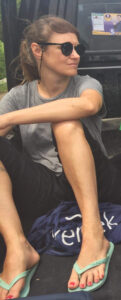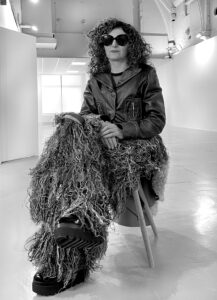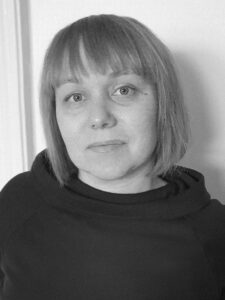Katya Buchatska / Катя Бучацька

– born in Kyiv in 1987. She studied at the Kyiv Polygraphic Institute, the École Nationale Supérieure d’Art de Dijon, and the Kyiv National Academy of Arts and Architecture (Faculty of Monumental Painting). She was a member of the “Montage” group. Katya Buchatska works with environmental art, photography, installation, and painting. Additionally, she is a member of a preservation group for the legacy of the Hutsul artist Paraska Plytka-Horytsvit. Buchatska finds importance in the environment—both artistic and natural—which is why her practice is primarily connected to understanding and exploring the environmental function, history, and future. When reflecting on her role during the war, the artist created what she called “her last painting” at the beginning of the full-scale invasion, which sparked an idea that later developed into new projects. There, the artist delves into the memories of tragedy embedded in the landscape. In 2024, Buchatska collaborates with neurodivergent artists on the “Best Wishes” project, which will be exhibited in the Ukrainian pavilion at La Biennale di Venezia. The artist lives and works in Kyiv.
I observe my body, and this body I like. Its movements are smart; they keep the balance. Sometimes, I notice its new position, which has never happened in its previous life.
I don’t think I would have politicized the whole environment without a military invasion of my country. The search for clarification of one’s boundaries is caused by the external.
Would I be so eager to appropriate, define, and name the land, animals, and places? Would I like this body just as much without constantly imagining its death? — I doubt it.
What was before the invasion? I don’t remember.
It is like imagining a person whose hometown is threatened by a volcanic eruption, yet they refuse to leave. And to be mesmerized by this decision and paint it, only to later find out that Werner Herzog has already made a movie about such a person1 in his La Soufrière, 1977.
And here you are, lying on the asphalt all by yourself, with the lava irreversibly moving into you. Perhaps, when your body is baked in the pyroclastic flow and disintegrates into dust, a loving assistant will retrieve your plaster pose from the void, and someone else will observe it in a museum23.
It’s like life before the crater, near the crater, and after the crater.
Time before the crater
I think Paraska Plytka-Horytsvit4 is somehow influencing my life. On February 21, 2022, Oleksandr Chayka5 and I traveled to Kryvorivnia to open the Horytsvit exhibition hall in a building of a former village council. Establishing a museum in Kryvorivnia has long been a goal of our initiative group6.
Because of Horytsvit, I didn’t hear the first explosions or experience the threat of being encircled by the enemy. She was also the reason why I was happy for the first time after the invasion, as we returned to Kryvorivnia for the second time in December to open the Plytka-Horytsvit Museum. My first year of the full-scale war began with the museum still closed and ended with its opening7. It served as an affirmation of life amidst reports of museum destruction. I was fearful to announce the opening dates and the museum’s location on social media due to the danger of potential shelling8910.
My works are written as a diary, in which I record only significant personal shifts; new knowledge about the universe and myself1112131415.
I painted what I thought would be my last painting in March 2022. It was a conscious farewell, a representation of the inertia of my previous life, which was already intertwined with new text and new names. The latter came from the names of the emerging weaponry16.
Time near the crater17
A crater is the embodiment of an inflicted force that is greater than man. There is a term “peak of eternal light,” but craters are only of “eternal darkness.” I gravitate more to solids than liquids. The frame, the structure, more bones than blood. On the territory of Ukraine, during the Eocene period, there are deposits of geological sediments of the Buchak formation — during this period, proto-amber was formed — I am ambitiously happy about this.
When the chest is misaligned with the pelvic bones, it causes a particular kind of pain: muffled, restraining soft tissue and breathing. A crater evokes similar sensations — the order of things, layers, horizons, ecosystems, time is destroyed, and time is mixed. In Greek, “crater” means “to mix.”
In May, in the already de-occupied, destroyed, blooming Moshchun, in a field near the chopped-up forest and burnt cars, I collect the first soil pigment from the crater. Ukrainian soils will become the basis for homemade oil paints, and this first one is Moshchun umber18.
As the number of craters increases, the idea of a living memorial on a shelling-torn field will take shape19.
This world is recording.
Time after the crater
It’s like travelling for a long time, looking out the window, and waiting for the next landscape to appear; waiting for the next destruction, and maniacally recording the landscape at 60 frames per second from the twelve windows of the Ukrzaliznytsia carriage. Fear of not remembering, of not having a thorough testimony. What kind of love is this supposed to be?2021
Here comes a time when the idea of art from the zero line becomes a point on the map. The front line is moving; zero lines become the rears of besieging; minuses and pluses become zero lines. It’s like the Undertaker in Malevich’s 1913 sketch carrying a black square as a flag, and then 110 years later, you find yourself digging in the black darkness of the soil, passed down to you by a warrior from the zero line; art and life, which is stronger than art, blend together.
I consider the black square, painted with the zero line chornozem (black soil) oil paint to be my best work22.
The text was written in a collaboration with Kateryna Iakovlenko (2024).
1Image: Katya Buchatska, I Don’t Want to Leave Here, 2020. Board, levkas, pencil, markers, oil, varnish, black lead, 24.5 x 49 cm. Courtesy of the artist.2Katya Buchatska describes her work Pain Record, created for the PinchukArtCentre Prize in 2020. In it, the artist creates a work dedicated to a non-existent palaeontologist and reflects on the role of museums and history in recreating historical narrative. Image: Katya Buchatska, Pain Record, 2020. Gypsum, natural materials, diary. Photographs provided by the PinchukArtCentre © 2020. Photographed by Maksym Bilousov.
3Image: Katya Buchatska, Pain Record, 2020. Showcase with a body. Documentation: Maksym Bilousov. Photo provided by the PinchukArtCentre.
4Paraska Plytka-Horytsvit (1927-1998) — a Ukrainian artist, ethnographer, and photographer who spent her entire life documenting the life of her hometown Kryvorivnia in Ivano-Frankivsk Oblast. Paraska Plytka-Horytsvit's legacy became known to the public only after the 2010s.
5Oleksandr Chayka is the Deputy Director of the Les Kurbas Centre, a friend of the Paraska Plytka-Horytsvit (PPH) Museum, and an Assistant in many matters related to the PPH heritage in Kryvorivnia.
6Preservation group for the legacy of the Hutsul naïve artist Paraska Plytka-Horytsvit was formed in 2016 when the photo archive of Horytsvit was found. As of 2024, its members include Maksym Rudenko, Inga Levi, Katya Buchatska, and Kateryna Radchenko.
7The museum was supposed to open in March 2022, but instead opened in late 2022.
8Image: A photo of the exhibition hall of the Paraska Plytka-Horytsvit Museum in the village of Kryvorivnia, Ivano-Frankivsk oblast, Ukraine, 2022. The author of the exhibition is Katya Buchatska.
9Image: Exhibition hall of the Paraska Plytka-Horytsvit Museum in the village of Kryvorivnia, Ivano-Frankivsk oblast, Ukraine, 2022. The author of the exhibition is Katya Buchatska.
10Image: A photo of the exhibition hall of the Paraska Plytka-Horytsvit Museum in the village of Kryvorivnia, Ivano-Frankivsk oblast, Ukraine, 2022. The author of the exhibition is Katya Buchatska.
11Image: Katya Buchatska, A Very Personal Show. Photos provided by The Naked Room, 2020. Photographer: Yevgen Nikiforov.
12Image: Katya Buchatska, The Colour of the Year, 2020. Extruded styrofoam, resin, levkas, pigment. Height: 54cm. Courtesy of the artist.
13Image: Katya Buchatska, Photographs From the Past Year. Photos provided by the Mala Gallery of the Mystetskyi Arsenal, 2019. Photographer: Oleksandr Prokopenko.
14Image: Katya Buchatska, What Does a Good Curator Do?, 2020. Courtesy of the artist.
15Image: Katya Buchatska, Preset (fragment), 2020. Courtesy of the artist.
16Image: Katya Buchatska, Spring Time, 2022. Oil, printing on canvas. 300 x 120 cm. The work was created during the Working Room residency. Courtesy of the artist.
17Image: Katya Buchatska, Photography of the crater in Moshchun village, 2022. Courtesy of the artist.
18Image: Katya Buchatska, Moshchun Umber, 2022. Hand-made oil paint on canvas, 50Х60 cm. Courtesy of the artist.
19Image: Katya Buchatska, This World is Recording, 2023. Video, 7'. Courtesy of the artist.
20Image: Katya Buchatska, Izyum to Liverpool, 2023. Installation at the Liverpool Cathedral. ©Rob Battersby.
21Image: Katya Buchatska, Izyum to Liverpool, 2023. Installation at the Liverpool Cathedral. ©Rob Battersby.
22Image: Katya Buchatska, Black From the Zero Line, 2023. Handmade oil paint on canvas. 80 x 80 cm. Courtesy of the artist.
— народилася у 1987 року в Києві. Навчалася у Київському поліграфічному інституті, у École Nationale Supérieure d’Art de Dijon, та у Національній академії мистецтв та архітектури у Києві (факультет монументального живопису). Була учасницею групи “Монтаж”. Катя Бучацька працює з середовищним мистецтвом, фотографією, інсталяцією, живописом. Вона також входила до групи митців та кураторів, які займалися дослідженням мистецької спадщини Параски Плитки-Горицвіт. Для художниці важливим є середовище — як мистецьке, так і довкілля як таке саме тому її практика більшою мірою апелює до того, як це середовище функціонує, яким була його історія та майбутнє про нього. Міркуючи про свою роль під час війни, Бучацька на початку повномасштабного російського вторгнення створила “свій останній живопис”, який насправді започаткував думку, з якої потім народилися нові проєкти, де увага авторки більшою мірою спрямована на пам’ять про трагедію, яку носить в собі ландшафт. Окрім того, у 2024 році художниця робить проєкт “Щирі Вітання” з нейровідмінними художницями і художниками для Українського павільойну на Венеційську бієнале. Живе і працює в Києві.
Я дивлюсь на своє тіло і це тіло подобається мені. Його рухи розумні, тримають баланс. Іноді я зауважую його нове положення, якого ще не траплялось впродовж попереднього життя.
Не думаю, що я б політизувала все оточення без військового вторгнення в свою країну. Пошук уточнень власних меж спричинений зовні.
Чи хотілось би мені так завзято присвоювати, окреслювати і називати землю, тварин, місце? Чи подобалось би мені це тіло так без щосекундного уявлення про його смерть? — Наврядчи.
Що було до вторгнення? Я не пам’ятаю.
Це як уявляти людину, в чиєму рідному місті починається виверження вулкану, проте вона не хоче полишати свій дім. Та бути завороженою цим рішенням і малювати його. А вже потім дізнаватись, що Вернер Херцог знімав фільм про таку людину1.
І ось ти вже і сама лежиш на асфальті і лава незворотньо рухається на тебе. Можливо, коли тіло спечеться у пірокластичному потоці і розпадеться в прах, люблячий асистент витягне твою гіпсову позу з пустоти і хтось інший роздивлятиметься її у музеї23.
Це як життя до вирви, біля вирви і після неї.
Час до вирви
Я думаю Параска Плитка-Горицвіт4. щось робить з моїм життям. 21 лютого 2022 я з Олександром Чайкою5. поїхали в Криворівню, щоб відкрити виставкову залу Горицвіт в колишньому приміщенні сільської ради. Створення музею в Криворівні було багаторічною метою нашої ініціативної групи6.
Через Горицвіт я не чула перших вибухів і не прожила загрозу близького оточення ворогом. Також через неї я вперше після вторгнення зраділа, коли ми повернулись в Криворівню вдруге, вже в грудні, щоб таки відкрити музей Плитки-Горицвіт. Мій перший рік повномасштабної війни почався з невідкритого музею і закінчився його відкриттям7. Це було ствердженням життя посеред новин про знищення музеїв. Я боялась анонсувати відкриття і місце в соцмережах8910.
Мої роботи пишуться як щоденник, у якому записані лише вагомі випадки особистісні випадки зрушень, нові знання про світобудову і себе1112131415.
Свою, як я думала тоді, “останню” живописну роботу, я писала в березні 2022-го. Це було свідомим прощанням-унаочненням інерцією попереднього життя, в яке вже вплітався новий текст і нові імена, названі на честь нової зброї16.
Час біля вирви17
Кратер — це факт завданої сили, більшої за людину. Існує термін «пік вічного світла», але кратери бувають лише «вічної пітьми». Я відчуваю більшу близькість до твердих порід, ніж до рідин. Каркас, структура, радше кістки ніж кров. На території України є залягання геологічних відкладів Бучацького часу з період Еоцену — в цей період формується протобурштин — честолюбно цьому радію.
Коли зрушується грудна клітка відносно тазових кісток це особливий тип болю, притлумлений, здавлюючий м’які тканини, дихання. Біля вирви схожі відчуття — нищиться порядок речей, шари, горизонти, екосистеми, час змішується. Грецькою «кратер» — це «змішувати».
У травневому, вже деокупованому, зруйнованому, квітучому Мощуні, в полі біля посіченого лісу і спалених автівок збираю першу землю-пігмент з вирви. Українські землі стануть основою для саморобних олійних фарб, ця перша — умбра Мощунська18.
Зі збільшенням кількості вирв навколо з’явиться ідея живого меморіалу на побитому снарядами полі19.
This world is recording.
Час після вирви
Це як предовго їхати, вдивлятись у вікно і очікувати на наступний пейзаж, очікувати на наступне руйнування і маніакально записувати ландшафт 60 кадрів в секунду з дванадцяти вікон вагону Укрзалізниці. Страх не запам’ятати, не мати ретельних свідчень. Що це за любов така має бути2021.
Настає час, коли ідея нуля мистецтва стає точкою на мапі. Лінія зіткнення рухома, нулі стають тиловими котлами, мінуси і плюси нулями. Це як Гробар на ескізі Малевича 1913 року несе чорний квадрат як прапор, а потім ти вже і сама через 110 років копирсаєшся в чорній пітьмі землі, переданої з нуля воїном; мистецтво та життя, яке сильніше за мистецтво, змішуються разом.
Я думаю про чорний квадрат написаний олійною фарбою з чорнозему з нуля, як про свою кращу роботу22.
Текст написано у співпраці з Катериною Яковленко (2024).
1Зображення: Катя Бучацька, Я не хочу йти звідси, 2017. Левкас, олівець, олія, маркери, графіт, дошка, лак. 24,5 x 49 см. Мається на увазі фільм В. Херцога La Soufrière, 1977.2Катя Бучацька описує свою роботу Рекорд болю, створену у 2020 році для Премії PinchukArtCentre 2020. У ній художниця створює роботу, присвячену неіснуючому палеонтологу та міркує про роль музею та історії у відтворенні історичної оповіді. Зображення: Катя Бучацька, Рекорд болю, 2020. Гіпс, щоденник, натуральні матеріали. Документація Максима Білоусова. Фото надане PinchukArtCentre.
3Зображення: Катя Бучацька, Рекорд болю, 2020. Вітрина з тілом. Документація Максима Білоусова. Фото надане PinchukArtCentre.
4Параска Плитка-Горицвіт (1927-1998) — українська художниця, етнографка, фотографка, яка все життя документувала життя свого села Криворівня на Івано-Франківщині. Спадщина Параски Плитки-Горицвіт стала відома широкому загалу лише після 2010-х.
5Олександр Чайка — заступник директора Центру Леся Курбаса, друг музею ППГ та помічник у багатьох питаннях стосовно спадщини ППГ в Криворівні.
6Ініціативна група по збереженню фотонасліддя Параски Плитки-Горицвіт виникла у 2016 році, коли був знайдений фотоархів гуцульської мисткині Горицвіт. На 2024-й рік в неї входять Максим Руденко, Інга Леві, Катя Бучацька, Катерина Радченко.
7Музей мав відкритися у березні 2022 року, натомість його відкриття відбулося наприкінці 2022-го.
8Зображення: Фотографія експозиції виставкової зали музею Параски Плитки-Горицвіт у с. Криворівня, Івано-Франківського району, Україна, 2022. Авторка експозиції Катя Бучацька.
9Зображення: Фотографія експозиції виставкової зали музею Параски Плитки-Горицвіт у с. Криворівня, Івано-Франківського району, Україна, 2022. Авторка експозиції Катя Бучацька.
10Зображення: Фотографія експозиції виставкової зали музею Параски Плитки-Горицвіт у с. Криворівня, Івано-Франківського району, Україна, 2022. Авторка експозиції Катя Бучацька.
11Зображення: Катя Бучацька, Дуже персональна виставка, Фотографії надані The Naked Room 2020. Фотограф: Євген Нікіфоров.
12Зображення: Катя Бучацька, Колір року, 2020. Екструдований пінопласт, смола, левкас, пігмент, 54 см. Надано авторкою.
13Зображення: Катя Бучацька, Фотографії з минулого року. Фотографії надані Мала Галерея Мистецького Арсеналу, 2019. Фотограф: Олександр Попенко.
14Зображення: Катя Бучацька, Що робить хороший куратор?, 2020. Надано авторкою.
15Зображення: Катя Бучацька, фрагмент роботи Preset, 2020. Надано авторкою.
16Зображення: Катя Бучацька, Весна, 2022. Полотно, понотипія, олія. 300х120см. Робота зроблена в рамках резиденції “Робоча кімната”. Надано авторкою.
17Зображення: Катя Бучацька, фотографія воронки в с. Мощун, 2022. Надано авторкою.
18Зображення: Катя Бучацька, Умбра Мощунська, 2022. Саморобна олія на полотні. 50х60 см. Надано авторкою.
19Зображення: Катя Бучацька, Прінтскрін з роботи This world is recording, 2023, відео, 7’. Надано авторкою.
20Зображення: Катя Бучацька, Ізюм — Ліверпуль, 2023. Інсталяція у Ліверпульському Соборі. ©Rob Battersby.
21Зображення: Катя Бучацька, Ізюм — Ліверпуль, 2023. Інсталяція у Ліверпульському Соборі. ©Rob Battersby.
22Зображення: Катя Бучацька, Чорна з нуля, 2023. Саморобна фарба на полотні. 80х80 см. Надано авторкою.



